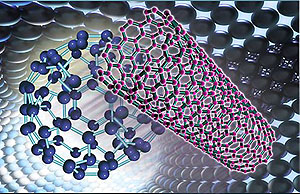
Program Description
At NIEHS, a unique combination of knowledge, expertise, and commitment to understanding the role of environmental exposures in human diseases enables a novel approach to the study of nanomaterials and their potential effects on human health. This field is known as Nano Environmental Health and Safety, or Nano EHS.
The challenges for conducting research on nanoscale materials — determining dose, assessing biological response, and quantifying exposure and risk — are similar to other paths in environmental health research.
What NIEHS is Doing
Recognizing that engineered nanomaterials (ENM) are increasingly being used in everyday products, such as pharmaceuticals, cosmetics, sunscreens, clothing, and electronics, NIEHS developed a federal interagency research strategy to explore this emerging field. The outcome will allow scientists to design nanomaterials that are both innovative and safe for commercialization.
NIEHS encourages and supports research into the underlying properties of ENM to determine their potential biocompatibility or toxicity to human health. Consortia established by NIEHS are aimed at building understanding of how unique chemical and physical properties at the nanoscale may affect interactions between environmental exposures and the body.
NIEHS prioritizes ENMs with a high potential for human exposure based on production volume and incorporation into common consumer products.
The Nano EHS program is also expanding its efforts to support research aimed at characterization of nano- and microplastics to address emerging health issues associated with these contaminants.

The Nanomaterials Health Implications Research (NHIR) Consortium links the physical and chemical properties of high priority ENMs and newly developed ENMs to biological responses using a variety of testing approaches (RFA-ES-15-012, RFA-ES-15-013). Knowledge gained from this collaborative research effort will allow scientists to predict potential health effects associated with diverse routes of exposure that represent real-world scenarios. The NHIR Consortium builds on the NIEHS Centers for Nanotechnology Health Implications Research Consortium, which demonstrated a clear relationship between the physical and chemical properties of a small group of ENMs and their toxicity at molecular, cellular, and whole organism levels.
The NIEHS Small Business Innovation Research (SBIR) and Small Business Technology Transfer (STTR) grants program helps small businesses develop innovative and commercially viable products or technologies across a broad spectrum of topic areas, including ENMs. These grants may support tools to better characterize exposure to ENMs and to expand the capability of screening the range of commonly used ENMs for effects in biological systems.
Visit the Past Nano EHS Research Programs webpage to read about research programs previously funded by NIEHS.
Learn more about the environmental health topic of nanomaterials on the NIEHS Health and Education webpage.
Program Contacts
-

-
Sri Nadadur, Ph.D.
Branch Chief; Exposure, Response, and Technology Branch (ERTB) -
Tel 984-287-3296
[email protected]
-

-
Lingamanaidu V. Ravichandran, Ph.D.
Health Scientist Administrator -
Tel 984-287-3309
[email protected]


